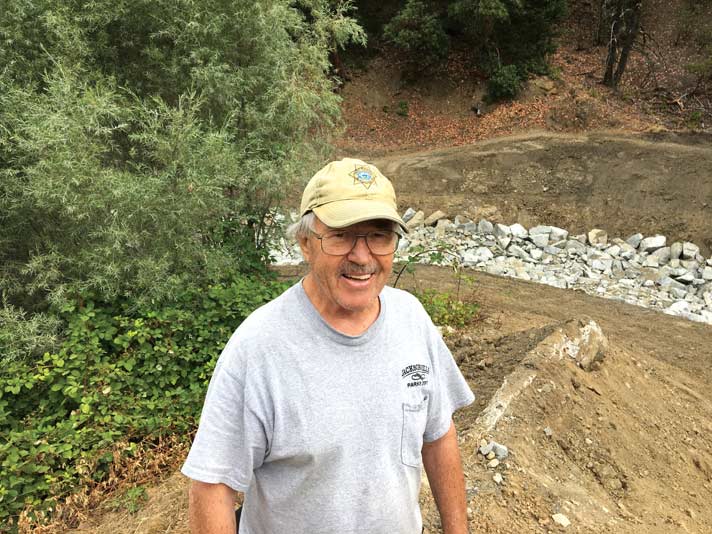The Jacksonville dam and reservoir was built in 1911, one mile west of town along Jackson Creek. It was built to provide a source of drinking water to the town via a wooden transmission line emanating from the city reservoir. In 1926, the wooden pipeline was replaced by a six-inch steel pipeline, and the dam was raised four feet to provide more storage.
The system provided Jacksonville’s drinking water until 1952, when the city approved connecting to Medford’s water supply, at which time the dam was closed as a water supply. The switch to Medford water was just in time, as in the next few years, a large fire swept through the mountains above the dam, destroying most of the vegetation in the watershed. This was followed by winters of very heavy rainfall, with resulting high sediment runoff filling ninety percent of the reservoir with decomposed granite, sands and gravels.
Jackson Creek continued to flow into and through the reservoir, with its seven-foot-deep pond. Water still flowed over the dam and down the undersized concrete spillway. However, over time, high stream flows kept undercutting the end of the spillway as it got shorter when big pieces broke off. For the next sixty-five years, all that remained was a small pond and a waterfall off the end of the broken spillway as the reservoir continued to be classified as a “dam and reservoir” by the state dam engineer.
By state law, even if a dam has ceased to be used as originally designed to store water, it must be maintained in a safe condition. Since the city wished to abandon it as a reservoir, the state mandated that the dam must be decommissioned in a manner that satisfied state and federal agencies so that the structure and the water flowing through pose no future threat to downstream areas.
Every year, the state dam engineer has inspected the dam, and given the city a report on the dam’s condition. In the last ten years, the state had become firmer in its requests that the city decommission the dam, hence the work done this past month to notch the dam, effectively removing it.
In 2010, the city had RVCOG do a study, and their recommendation contained estimates from $370,000 to $920,000 to cut a deep notch in the dam and haul away much of the reservoir sediments. The city then hired an engineering firm to provide a detailed design which had an estimated cost of $750,000. Realizing this cost was overwhelming to a town Jacksonville’s size, the state dam engineer reexamined the dam and concluded the sediments could safely stay in-place.
However, the state concluded, the undersized and broken concrete spillway needed to be removed and replaced with a natural new streambed. The old spillway went down to the bottom of the dam where the creek resumes its slow and gradual path to town. The design was completed by the city’s engineering firm and the project put-up for bid in the spring of 2016, with a low bid of $75,000 from Kogap.
Today the new stream channel has been constructed by building a twenty-foot-wide channel filled with three-foot diameter boulders, each weighing over 1,000 pounds, terminating with a thirty- foot steep plunge to the streambed below. The reservoir pond will be retained, but is just a little smaller, having been lowered three feet. The pond will continue to be home to ducks, geese, and big turtles from fall through spring, until the hot summer months dry it up temporarily.
Two Forest Park trails pass close to the pond and to the newly-built stream, providing visitors a close-up experience with the wildlife. So why is the dam no longer a dam in the eyes of the state dam engineer? Because on his last inspection trip during the construction project, he stood on the dam and declared it no longer a dam, but just a hill with the stream running over it. It’s official: the Jacksonville Dam is no longer a dam!
